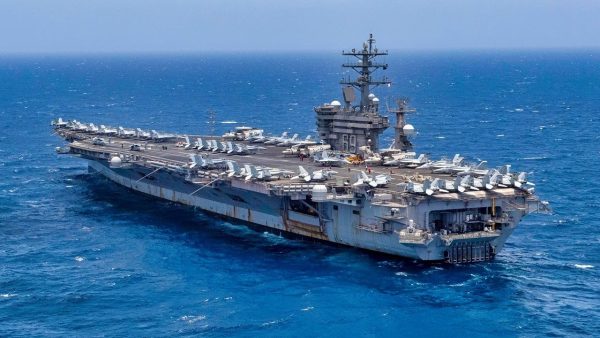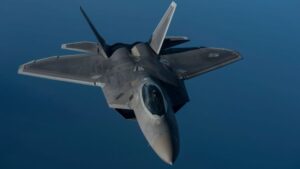The following article first appeared on Warrior Maven, a Military Content Group Website.
For many years now, we’ve heard variations of different arguments about the extent to which long-range, precision-guided Chinese anti-ship “carrier killer” missiles could make US Navy carriers obsolete or at least very vulnerable and challenged to operate at distances within reach of attack. Is this true? Certainly, the Navy seems to recognize the seriousness of this threat and is fast evolving smaller, faster maritime warfare platforms, a growing sphere of unmanned systems, and an ability to extend fighter-jet attack range from distances where carriers might be less vulnerable. We’ve all heard of Chinese “carrier-killer” missiles as they have been widely discussed and “hyped” by Chinese government-backed newspapers. What about Iran?
Now, alongside the well-known Pacific threat, US Navy Carrier Strike Groups have been projecting power in the Middle East in direct response to growing threats and escalations from Iran and its “proxy” forces attacking Israel. What kind of anti-ship-cruise missile threat might Iran have presented to the USS Ford and USS Dwight D. Eisenhower Carrier Strike Groups when they were in the Eastern Mediterranean?
Iran does produce several long-range cruise missiles of relevance to any possible carrier threat to the US Navy in the Middle East. While they are primarily a threat for the Persian Gulf and Strait of Hormuz closer to Iranian coastline, it is realistic they could also threaten Israel and portions of the Eastern Mediterranean from Iran or its “proxy” attack locations throughout the region. The Chinese DF-26 reportedly hits ranges out to 2,000 miles and attacks with some precision, so how comparable are fast-evolving Iranian equivalents?
Iranian Long-Range Cruise Missiles
An interesting research essay published by Iran Watch lists two new, testing and “possibly deployed” long-range Iranian cruise missiles, the Soumar and the Hoveizeh. The Soumar missile, which is estimated to operate at a range up to 3,000km, a distance which would hold US Navy Carrier Strike Groups at risk. The Hoveizeh is potentially more current as it is described as a variant of the Soumar family and capable of hitting targets out to 839miles. Perhaps of greatest significance, the Hoveizeh is cited as a precision weapon able to use inertial navigation systems to hit targets within as little as one meter of accuracy. This claim may or may not be true, yet INS technology of this kind does seem to exist. The Hoveizeh also operates in “sea-skimming” mode like many anti-ship cruise missiles in order to fly below the radar aperture and avoid detection while en route to a target. How dangerous are these missiles?
In order to be able to project power from the ocean over large portions of the Middle East, US Navy Carriers would ideally not want to be further than a few hundred miles off the coast so aircraft can conduct sorties within their operational range, have some dwell time over target and be able to return without refueling.
The following article first appeared on Warrior Maven, a Military Content Group Website.
For many years now, we’ve heard variations of different arguments about the extent to which long-range, precision-guided Chinese anti-ship “carrier killer” missiles could make US Navy carriers obsolete or at least very vulnerable and challenged to operate at distances within reach of attack. Is this true? Certainly, the Navy seems to recognize the seriousness of this threat and is fast evolving smaller, faster maritime warfare platforms, a growing sphere of unmanned systems, and an ability to extend fighter-jet attack range from distances where carriers might be less vulnerable. We’ve all heard of Chinese “carrier-killer” missiles as they have been widely discussed and “hyped” by Chinese government-backed newspapers. What about Iran?
Now, alongside the well-known Pacific threat, US Navy Carrier Strike Groups have been projecting power in the Middle East in direct response to growing threats and escalations from Iran and its “proxy” forces attacking Israel. What kind of anti-ship-cruise missile threat might Iran have presented to the USS Ford and USS Dwight D. Eisenhower Carrier Strike Groups when they were in the Eastern Mediterranean?
Iran does produce several long-range cruise missiles of relevance to any possible carrier threat to the US Navy in the Middle East. While they are primarily a threat for the Persian Gulf and Strait of Hormuz closer to Iranian coastline, it is realistic they could also threaten Israel and portions of the Eastern Mediterranean from Iran or its “proxy” attack locations throughout the region. The Chinese DF-26 reportedly hits ranges out to 2,000 miles and attacks with some precision, so how comparable are fast-evolving Iranian equivalents?
Iranian Long-Range Cruise Missiles
An interesting research essay published by Iran Watch lists two new, testing and “possibly deployed” long-range Iranian cruise missiles, the Soumar and the Hoveizeh. The Soumar missile, which is estimated to operate at a range up to 3,000km, a distance which would hold US Navy Carrier Strike Groups at risk. The Hoveizeh is potentially more current as it is described as a variant of the Soumar family and capable of hitting targets out to 839miles. Perhaps of greatest significance, the Hoveizeh is cited as a precision weapon able to use inertial navigation systems to hit targets within as little as one meter of accuracy. This claim may or may not be true, yet INS technology of this kind does seem to exist. The Hoveizeh also operates in “sea-skimming” mode like many anti-ship cruise missiles in order to fly below the radar aperture and avoid detection while en route to a target. How dangerous are these missiles?
In order to be able to project power from the ocean over large portions of the Middle East, US Navy Carriers would ideally not want to be further than a few hundred miles off the coast so aircraft can conduct sorties within their operational range, have some dwell time over target and be able to return without refueling.
“The origin of the Soumar appears to be from the nuclear-capable Russian Kh-55. In 2005, Russia acknowledged that 12 Kh-55s (without nuclear warheads) were illegally sold to Iran in 2001 through a black market counterfeit operation,” a Center for Strategic and International Studies “Missile Threat” essay explains.
There are still several key unknowns here, such as the extent to which Iran has its production and technological capacity to produce, maintain, and upgrade this missile. Are there large numbers of Soumars, and what kind of arsenal does the Iranian military have? Perhaps most of all, what kind of guidance systems might the Soumar missile have? Can it track moving targets? Is there a level of precision? Does the Hoveizeh truly operate with a kind of INS precision out to ranges of 839 miles? If true, the weapon would appear to place US carriers at risk from a number of Middle Eastern coastal locations of possible use by Iranian proxy forces.
Regardless, there is a strong reason to think US Navy Carrier Strike Groups Would be well positioned to destroy, defend against or simply “stop” incoming Soumars in flight.
Can US Navy F-35Cs Reach Iran and Enemy Land Targets in Middle East?
An F-35C, for example, is the longest range F-35 variant and can operate at ranges of 2,200km. Roughly speaking, it would need to take off from a carrier less than 1000km (500 miles) off shore in order to attack and return without needing to refuel. Therefore, if Iran has long-range anti-ship missiles able to travel as far as 2,000 to 3,000km, then carriers launching F-35Cs might need to operate within their strike range in order to launch air-attack missions, unless there were sufficient available refueling tankers. Using tankers, however, is not uncomplicated because, as large ‘non-stealthy” aircraft, refuelers would be quite vulnerable to enemy fire and possibly put fighter jets at risk as well.
There are always a number of variables able to impact the equation regarding range and vulnerability, depending upon where fighter jets are planning to attack on land and how much time they need over targets. If large manned tankers too vulnerable, there could be the possibility of a carrier-launched unmanned MQ-25 Stingray refueler drone, a more survivable and now operational drone tanker.
Carrier Strike Group Layered Defenses — “Jam” Iranian Cruise Missiles
There is a lesser known part of this equation which might account for why the US Navy remains clear that it can operate carriers wherever it needs to regardless of new or emerging threats. The reason is clear …. improved ship defenses.
The Chinese DF-26, for example, can hit ranges out to 2,000 nautical miles and, in effect, seek to make it impossible for US Navy carriers to project air-attack power within operationally realistic ranges. However, the Navy has always been pretty confident about its ability to operate carriers in a modern threat environment, and while adjustments to the threat and smaller, faster carrier-like warships are being explored by the Navy, big deck carriers are not disappearing anytime soon. One reason may be the effectiveness of lesser known, yet increasingly high-tech layered ship defenses sufficient to address an anti-ship missile threat. Electronic Warfare systems are increasingly able to “jam” guidance systems of incoming missiles, ship-launched interceptor missiles are getting more precise, longer-range and capable of targeting attacking cruise missiles at safer stand-off ranges and new defenses such as lasers are showing a growing ability to track and incinerate incomjng anti-ship cruise missiles.
Destroyers protecting Carriers in Carrier Strike Groups now operate with a new generation of ship-protection technologies, the specifics of which are often not available for security reasons. US Navy DDG 51 Arleigh Burke class destroyers are now armed with lasers, improved range high-fidelity radar, upgraded interceptors and a new generation of more precise electronic warfare technology called SEWIP Block III. Closer in interceptors such as SeaRAM, Rolling AirFrame Missile and Close-in-Weapons System have also been upgraded as well.
There is also a lesser-known yet already deployed ship-defense system operational on Navy destroyers since 2015. It’s called Naval Integrated Fire Control – Counter Air. It is an integrated system that connects ship-based radar targeting technology with an aerial “node” or “gateway,” such as a Hawkeye surveillance plane or F-35 as a “relay” able to track and see incoming anti-ship missiles from stand-off ranges beyond the horizon. This NIFC-CA system removes latency and massively truncates the time window with which a ship commander has to respond to a threat or decide upon an optimal countermeasure. Simply put, threats can be seen much more quickly and at “beyond-the-radar-horizon” distances. In addition to just detecting an approaching threat, the NIFC-CA system also integrates an SM-6 interceptor missile, which can be cued by ship-based command and control with target detail and then launched to intercept and destroy an enemy anti-ship missile from beyond-the-horizon ranges.



